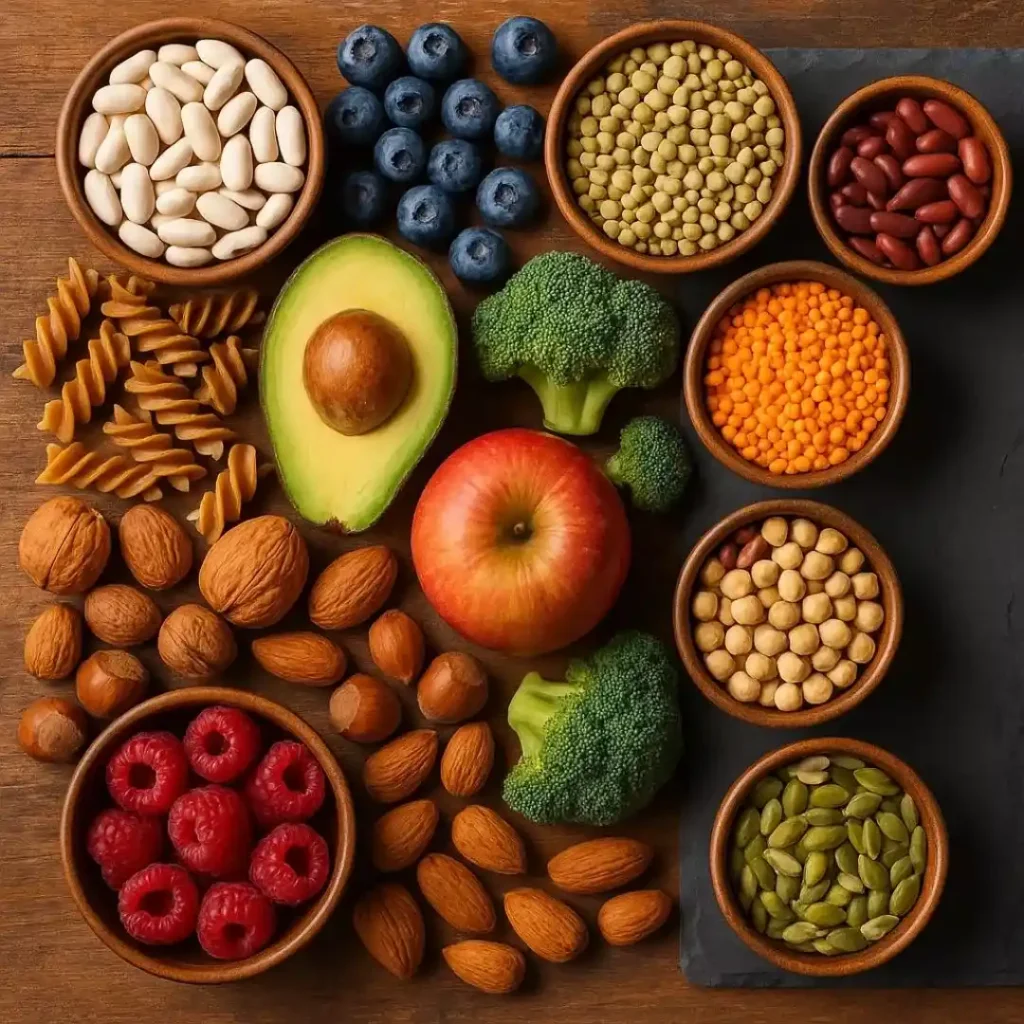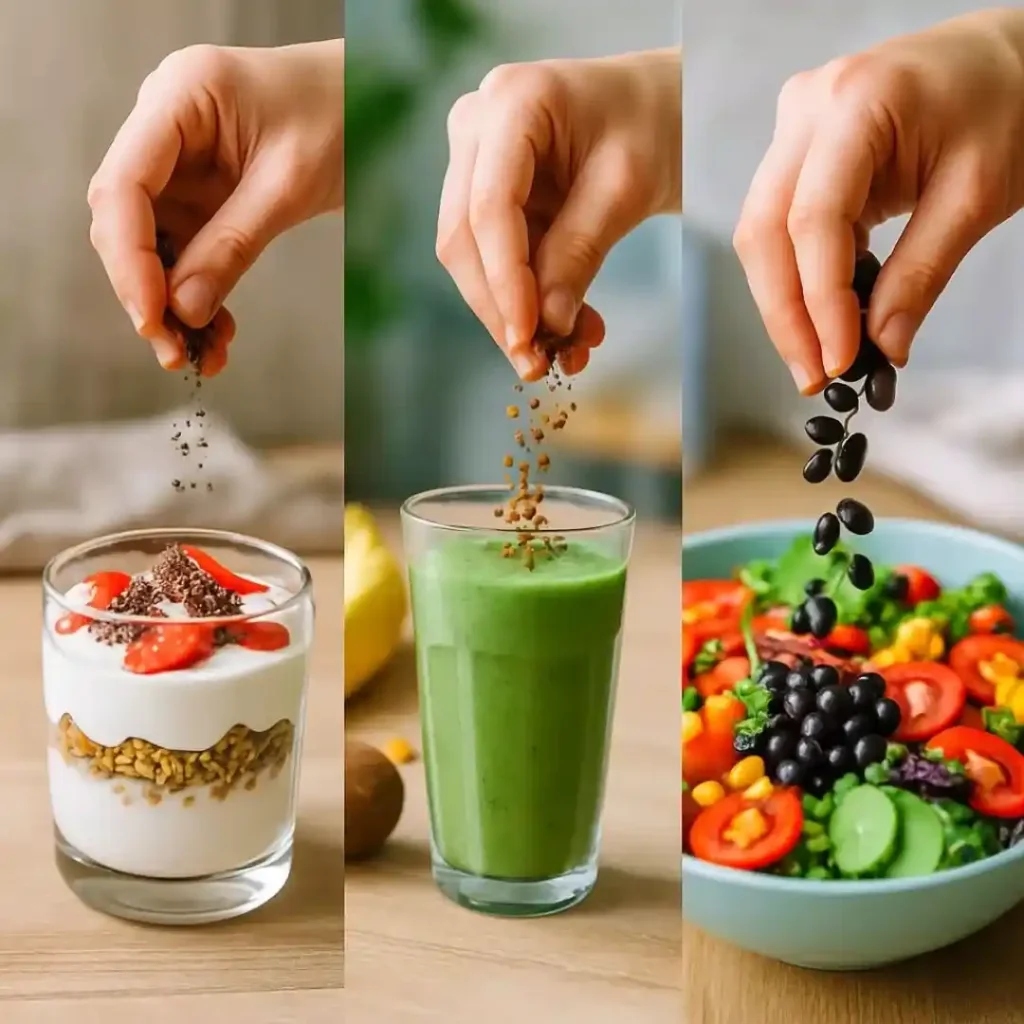
When I first started paying attention to nutrition, I assumed fiber was just about preventing constipation. But after years of experimenting with my diet, I realized fiber affects almost every aspect of health — from energy levels and gut balance to mood and weight management.
What Is Dietary Fiber?
Dietary fiber is a type of carbohydrate that the body cannot digest. Unlike sugars and starches that break down into glucose, fiber passes through the digestive system intact. There are two types of dietary fiber: soluble and insoluble.
| Type of Fiber | Sources | Health Benefits |
|---|---|---|
| Soluble Fiber | Oats, apples, beans, citrus fruits | Lowers cholesterol and stabilizes blood sugar |
| Insoluble Fiber | Whole grains, nuts, vegetables | Supports digestion and prevents constipation |
Soluble fiber dissolves in water to form a gel-like substance that helps lower cholesterol and control blood sugar levels. Insoluble fiber adds bulk to the stool, promoting regular bowel movements and preventing digestive issues.
Why Fiber Matters for a Healthy Diet
According to the American Heart Association, fiber helps maintain heart health by reducing LDL (bad) cholesterol. In addition, it supports a healthy gut microbiome, which influences immunity, digestion, and even mental well-being. The World Health Organization also highlights fiber’s role in reducing the risk of chronic diseases such as diabetes and heart disease.
Recommended Daily Fiber Intake
The Dietary Guidelines for Americans recommend that adult women consume about 21–25 grams of fiber daily, while men need around 30–38 grams. Unfortunately, most people only reach half that amount. Increasing fiber intake doesn’t require drastic changes; it’s about making smarter food choices.
The Major Health Benefits of Fiber
Fiber plays multiple roles in maintaining long-term health, and understanding these benefits can help you make better dietary decisions.

Supports Digestive Health
Fiber promotes bowel regularity and nourishes healthy gut bacteria. A diet rich in fiber-rich foods such as fruits, vegetables, and whole grains helps prevent constipation and supports overall digestive health. Researchers have also found that individuals with a high-fiber diet tend to have a more diverse and balanced gut microbiome, which directly affects immunity and inflammation.
Helps in Weight Management
If you’ve ever struggled with cravings or overeating, fiber can be your ally. High-fiber foods keep you full for longer periods, reducing hunger and calorie intake. For example, replacing white rice with brown rice or adding lentils to your salads can make a noticeable difference in satiety.
High-fiber snacks to try:
- Apple slices with peanut butter
- Roasted chickpeas
- Oatmeal topped with berries
- Chia pudding
Lowers Cholesterol and Improves Heart Health
Soluble fiber binds to cholesterol in the digestive system, helping the body eliminate it before absorption. This process effectively reduces total and LDL cholesterol levels. Studies published by the Mayo Clinic confirm that consuming 5 to 10 grams of soluble fiber daily can lower cholesterol by up to 10 percent.
Balances Blood Sugar Levels
Fiber slows the absorption of sugar, helping maintain stable glucose levels. For people managing diabetes or insulin resistance, this can prevent sudden spikes and drops in blood sugar. Whole grains, oats, and legumes are particularly effective for this purpose.
Best Sources of Fiber in Everyday Diet
Adding more fiber to your meals doesn’t have to be complicated. By making small adjustments, you can easily meet your daily requirements.
Whole Grains and Cereals
Choose whole grains like oats, barley, quinoa, and brown rice. When reading food labels, look for “whole” as the first ingredient to ensure you’re getting natural fiber.
Fruits and Vegetables
Fruits such as apples, pears, and berries are rich in soluble fiber, while vegetables like carrots, spinach, and broccoli are excellent sources of insoluble fiber. A simple rule of thumb is to include as many colors as possible in your plate — it ensures a variety of nutrients and fiber types.
Legumes, Nuts, and Seeds
Beans, lentils, chickpeas, chia seeds, and almonds are among the richest fiber sources.
| Food | Fiber (g per 100g) |
|---|---|
| Lentils | 7.9 |
| Chickpeas | 7.6 |
| Chia Seeds | 34 |
| Almonds | 12.5 |
Fiber Supplements — Do You Need Them?
For those who find it difficult to meet their daily intake through food alone, fiber supplements such as psyllium husk, Metamucil, or Benefiber can be effective. However, supplements should complement, not replace, natural sources.

Benefiber Daily Prebiotic Fiber Supplement
Daily Prebiotic Fiber Supplement Powder for Digestive Health, Unflavored – 125 Servings

Metamucil 4-in-1 Psyllium Husk Fiber Supplement
114 tablespoons, Orange Flavored, Daily Fiber Powder for Digestive Health, made with Plant-Based Psyllium Husk Fiber
How to Add More Fiber to Your Meals
A few mindful changes can significantly boost your fiber intake without much effort.
Smart Substitutions
Replace white bread with whole-grain options, swap pasta for quinoa, and use oatmeal instead of sugary cereals.
Plan High-Fiber Meals
A simple, balanced meal plan can help you meet your daily needs.
| Meal | Example | Approx. Fiber (g) |
|---|---|---|
| Breakfast | Oatmeal with berries | 10 |
| Lunch | Lentil soup and salad | 15 |
| Dinner | Grilled salmon with quinoa and vegetables | 8 |
Stay Hydrated
As you increase fiber, make sure to drink enough water. Fiber absorbs water to move smoothly through the digestive system. Without hydration, it may lead to bloating or discomfort.
Gradual Increase
If your current intake is low, increase fiber gradually to allow your digestive system to adjust. Rapid changes can cause temporary gas or bloating.
Common Fiber Myths and Mistakes to Avoid
Despite its importance, there are many misconceptions about fiber.
Myths about High Fiber Foods
- 1: All Fiber Is the Same: Soluble and insoluble fibers serve different functions. For example, soluble fiber regulates cholesterol, while insoluble fiber aids digestion. Both are essential for overall health.
- 2: Fiber Supplements Replace Whole Foods: While supplements are helpful, natural sources like vegetables, fruits, and grains provide additional vitamins and antioxidants that fiber powders lack.

Boost your daily fiber intake the easy way with Metamucil Fiber Gummies for Adults. These no-sugar-added orange-flavored gummies deliver 5g of prebiotic, plant-based fiber to support digestive health and regularity. Grab your 120-count bottle today and feel the difference in your gut health!
Mistakes to Avoid
- 1: Not Drinking Enough Water: Increasing fiber without water can lead to constipation or stomach discomfort. Always balance your intake with fluids.
- 2: Ignoring Food Labels: Check the Nutrition Facts on packaged foods and aim for products containing at least 3 grams of fiber per serving.
FAQs
What foods are extremely high in fiber?
Legumes are the highest, followed by seeds, whole grains, and certain fruits/vegetables. Top choices include:
Legumes: Split peas, lentils, black beans.
Seeds: Chia seeds, flaxseeds.
Whole Grains: Bran flakes, quinoa, oats.
Fruits/Vegetables: Avocado, raspberries, artichokes, broccoli.
What food has fiber for constipation?
Prunes (dried plums) are the top choice. They are high in both soluble fiber and sorbitol, a natural sugar alcohol with a laxative effect. Other excellent options include pears, apples with skin, chia seeds soaked in water, and leafy greens like spinach. Always increase water intake when adding these foods.
How can I increase my fiber intake?
Swap Grains: Choose whole-wheat bread, brown rice, and oats over refined versions.
Add Seeds: Mix chia, flax, or hemp seeds into yogurt, oatmeal, or smoothies.
Snack Smart: Eat nuts, popcorn, or raw vegetables with hummus.
Boost Meals: Add beans or lentils to soups, salads, and sauces. Start slowly and drink plenty of water.
How can I get 30g of fiber a day?
A sample day to reach 30g:
Breakfast: 1 cup oatmeal (4g) with 1 cup raspberries (8g).
Lunch: Salad with 1/2 cup chickpeas (6g) and an apple (4g).
Snack: 1 oz almonds (3.5g) and a pear (5g).
Dinner: 1 cup cooked quinoa (5g) with broccoli (5g).
This totals over 40g, showing how small, consistent choices add up.
Final Thoughts — Nourish Your Body with the Power of Fiber
The role of fiber in a healthy diet goes far beyond digestion. It influences heart health, weight control, and long-term vitality. Simple choices, such as choosing whole grains over refined ones or adding a handful of beans to your lunch, can significantly improve your well-being. Start small, stay consistent, and your body will thank you.
This post may contain affiliate links. If you purchase through them, I may earn a small commission at no extra cost to you. I only recommend products I personally trust and believe will benefit your health.




